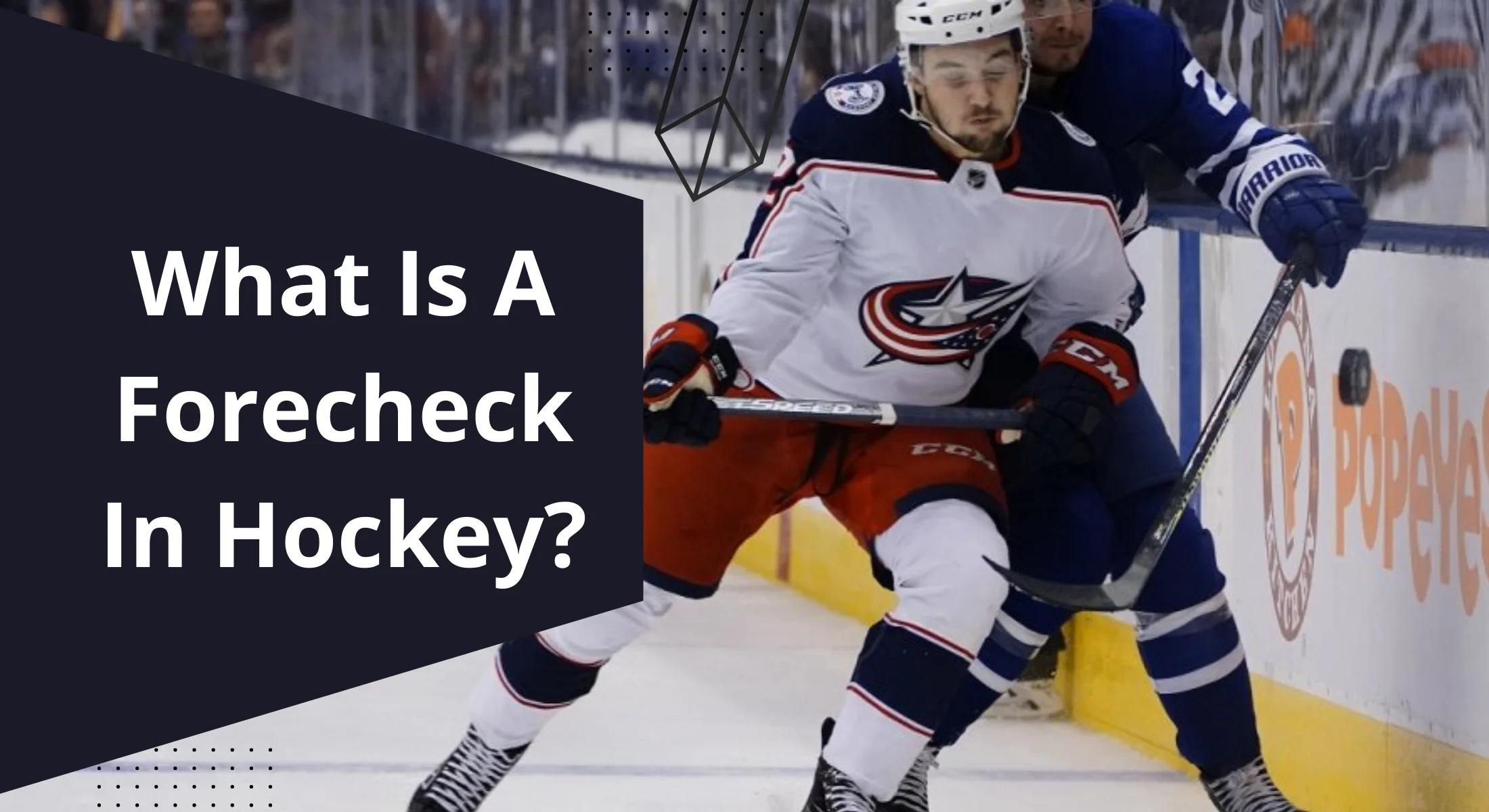It is important to learn ice hockey playing tactics if you want to win the game. Forechecking in hockey is among the two basic types of hockey schemes; the other one is Backchecking. Forechecking can be a difficult concept to grasp when you are just starting to learn the sport of ice hockey. However, to be honest, these winning tacts are not that hard to pick up if you are keen to learn. So, what is forecheck hockey?
With forechecking, teams put pressure on their opponents in the offensive zone so they can take possession of the puck by pushing them to make a turnover. In a hockey game, a team may employ or implement a variety of forechecking strategies.
What is Forechecking in Hockey?
Ice hockey’s forechecking is an attempt to put pressure on the other team to reclaim possession of the puck. It’s a way of doing a quality control check. In the majority of cases, forechecking is used to:
- Recover the puck after just a dump in
- After a rebound on a scoring attempt
- Soon after a turnover to save possession of the ball.
One to three players exert pressure in the attacking zone in a typical forecheck scenario. The main player chases after free pucks or pursues the player who has possession of them. A clear-out effort along the boards would be covered by the other two players, who would be cutting off the expected pass recipient.
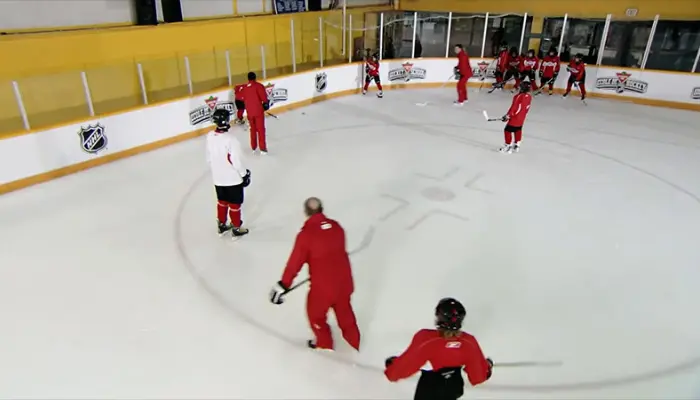
Historically, the team’s three forecheckers have been its three forwards. It’s rare to see a defenseman move behind the goal line to aid in puck recovery in today’s game.
As soon as the defenseman realizes they can no longer be an effective force on the forecheck, they will quickly withdraw back into their zone.
Related Post: Can You Kick the Puck in Hockey?
What are some of the Forechecking systems a team will use?
There are five forechecking systems that a team uses to get the winning edge.
1-4 Conservative Trap

Purpose: When it comes to forechecking, a 1-4, often known as a trap, is the most conservative option. Four skaters stand up on either side of the blue line to form a “four-man wall” to keep the other team from getting into the neutral zone. You’re playing defense with four skaters.
Players: For teams lacking in talent and skill, this is a common method of play. When a less talented team is seeking to halt a more talented squad, this strategy is used. Often at the end of a game, it is utilized to try and preserve a lead.
Facts
- Teams will not stick with this formation throughout the entire match.
- This forecheck will only be used by teams in specific circumstances going forward following the lockout.
- A team may choose to trap late in a period, whereas another team may choose to trap just when they have the advantage in the game. Teams no longer trap for the full 60 minutes.
1-2-2 Moderate Forecheck
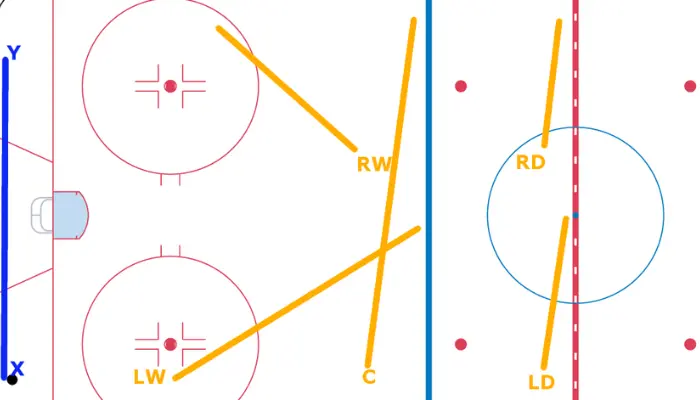
Purpose: The most prevalent approach in a game is the 1-2-2 Strategy. When the game is tight in terms of score and/or time remaining, this is your typical tactic.
Players: One player is the primary forechecker, while two other forwards provide additional help for the goaltender. These two forwards are tasked with disrupting a pass, grabbing a loose puck, or providing assistance along the boards. ‘
Facts
- When the action comes to them, the two defensemen standstill.
- The forecheck will be more effective if the puck is recovered or if the team retreats.
2-1-2 Aggressive Forecheck

Purpose: It’s a three-on-three situation here, with two forechecking players scurrying to the puck and a third lurking just outside of the faceoff circle.
Players: A team of experts is needed to pull this off. The team must continually communicate with each other, particularly between the center and the defense. As they progress, the group’s skaters must be excellent, and they must be able to quickly adjust to new conditions and read plays accurately.
Fact
- It’s a challenge to master this system.
- As they protect and support each other, the players will switch positions.
- Attack the opposition whenever possible and in every possible location.
- The forward needs to know when to return to cover the defense since the defensemen are more proactive and will sometimes pinch up along the boards.
1-3-1 Neutral Zone Forecheck
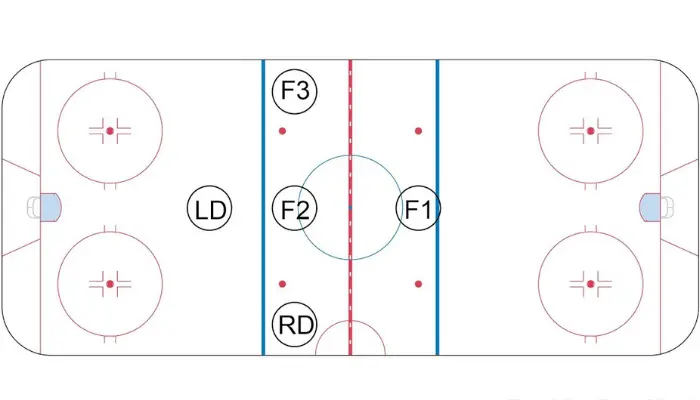
Purpose: Guy Boucher in Tampa Bay came up with the 1-3-1 as a newer forecheck. There are two ways to play with the 1-3-1; one is an aggressive forecheck and the other is a neutral zone trap.
Players: The first skater enters the zone and directs the puck toward the outside. While the right-side defenseman skates along the wall with two forwards to his left. Finally, the left-side defenseman follows the play. Since you have four skaters on the bottom attacking the puck in waves, the opposing team’s defensive assignments tend to become messed up.
Facts
- Allows forward-thinking counterattacks.
- Prevents the opposition from going 3-on-2.
- To get around, he skates forward.
- Adjustments can be made to make the left-wing lock stiffer.
3-2 Counter-attack Forecheck
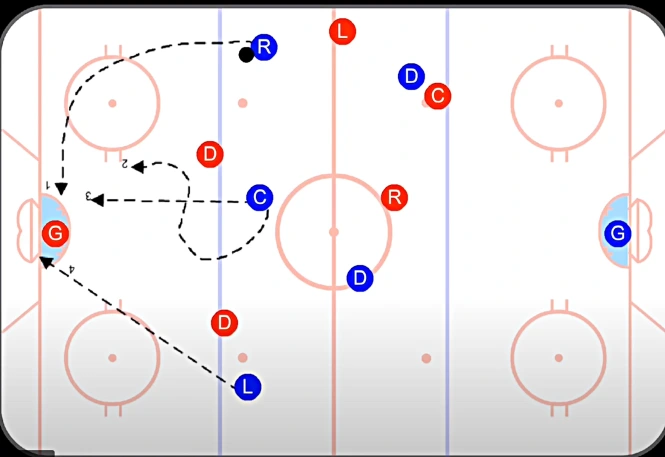
Purpose: Toward face-off or at the end of the period, this technique is used when it is improbable that a team can counterattack to create a scoring opportunity. As a result of their positioning, all three forwards will be exerting pressure on the puck in an attempt to force a turnover. After a player commits a turnover, the team will immediately assault the net.
Players: These are normally the team’s best-scoring forwards, as they are likely to be on the field at the time. With this level of pressure, a player must be an excellent skater and quick with the puck to succeed.
Facts
- Three forwards pressing the puck simultaneously is an important strategy.
- An aggressive and nimble approach.
- Done at critical moments, such as the conclusion of the period.
Related Post: Why Do Hockey Players Leave Their Sticks On The Ice?
How do you teach Forechecking in Hockey?
Communication
When it comes to communication, may be broken down into pre-game, team, and goalkeeper conversations.
When it comes to pre-game communication, it’s not just in the locker room. Every exercise and drill helps you create an intuitive connection with your teammates. That is why each hockey player must show up, encompass, and put in the hard work on every practice day.
Positioning
To counter odd-man rushes, the second principle of defense is to maintain good positioning. Players must be able to anticipate odd-man rushes to effectively defend against them.
Game Situation
For the sake of the game, a team must learn to play one kind of forechecking well. If forechecking does not go well, then it is possible to imply other strategies for a good game.
Awareness
The final but possibly most critical aspect in fighting against an odd-man rush is awareness. In order for a player to be aware, they must be able to communicate effectively, comprehend their position, and commit to defensive play.
What are F1 F2 F3 in Hockey?
The three forward positions in hockey are the center, left-wing, and right wing. Most coaches choose to use F1, F2, and F3 instead of these designations to identify their forwards. “F” is used since each player is a forward and the numbers indicate the order in which they are entered into the zone by coaches.

To put the defense in a difficult position, The”Fs” have specific functions:
F1: The F1 pushes the puck forward and assaults the net.
F2: The first-line helper, F2, takes up a position to recover the puck if the first liner drops.
F3: For a speedy change of ends, the F3 stays back to keep the puck in front of him.
Related Post: Dump and Chase
Is there any distinction between Forecheck and Backcheck in Ice Hockey?
Both of these abilities are essential because they help your team to:
- Stay in the attacking zone
- Prevent goals from being scored
- Turn the puck over more often
The fast-paced game of hockey that everyone knows and loves simply could not exist in its current form without the backcheck and the forecheck.
What is the difference between Forecheck and Backcheck?
Forechecking
In a wide variety of different contexts, performing a forecheck is necessary. After a player dumps the ball into the offensive zone, the players on the offensive team may have to work hard to drive the defensive players from the opposing team back to gain possession of the puck.
Backchecking
Strong backchecking is the foundation of a strong defense. If the opposing team passes the puck into the defensive zone or the offensive player for the opposing team is forced to hunt after the puck. In both cases, your team will have a better chance of defending the net.
Frequently Asked Questions
Is it necessary to have a check in Hockey?
In Hockey, how do you counter a Forecheck?
What is the best Forecheck System in Ice Hockey?
On Ice Hockey, ‘f’ stands for what?
Conclusion: What is a Forecheck in Hockey?
Both backchecking and forechecking are fundamental skills that every player and team must be able to execute effectively. In addition, these are not the types of talents that can be acquired after a single session of practice; rather, they are the types of skills that need to be constantly examined and refined for as long as a person continues to play hockey.

